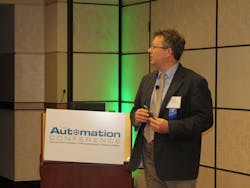Seven years ago, 93 percent of Europe’s oil refineries were generating a profit. And then the bottom fell out. “After the economic crisis, the situation changed significantly. Profits dropped and melted,” said Gábor Bereznai, director of control and electrical engineering at the MOL Danube Refinery in Százhalombatta, Hungary, near Budapest. “In 2009, loss-generating companies reached 35 percent.”
Bereznai, speaking to attendees of The Automation Conference last month in Chicago, was explaining how in an environment where refineries were fighting for profit, it became important to pay closer attention to asset reliability and availability.
And those assets are considerable. Though relatively small on a list of major global players, the Danube location is an important refinery for Central Europe. It processes crude and alternative crude oils from the Friendship and Adria pipelines, and is the leading producer of clean fuels for the Hungarian market, producing diesel and gasoline blended with bio components.
MOL has 58 process units at the Danube refinery, 95 percent of which are equipped with distributed control systems (DCSs) and safety PLCs. Many of the critical units are on serial connections, so if one breaks down, they all stop, Bereznai said, making reliability that much more critical.
The MOL Danube Refinery received the HART Plant of the Year Award in 2010 for its demonstrated creativity in the use of HART devices. The refinery had made the decision to install HART-enabled intelligent field instruments as part of a maintenance strategy to increase operational reliability.
Today, some 30,000 analog instruments at the refinery are HART-enabled; other instruments include 8,000 pneumatic devices (standard 4-20 mA) and 2,000 Foundation Fieldbus devices. About 3,000 of the HART devices are connected directly into a computerized maintenance management system (CMMS), including an online field instrumentation maintenance system (FIMS).
The difference in how the refinery does maintenance has been considerable. Since integrating the asset management system with the DCS and CMMS, Danube has seen a significant impact on unplanned downtime, on units both with and without FIMS, though units with FIMS. “Where we have a diagnostic system, the unplanned downtime is much less than where we didn’t have a diagnostic system,” Bereznai noted. They can save $350,000/year with online FIMS. Return on investment is reached in just three years, he added (see chart, above).
As one audience member noted, it’s all too typical for plants to use HART-enabled instruments without making use of the available HART data. Bereznai agreed that it is common for operations to do little more with the data than to support calibrations. But the MOL Danube Refinery made the decision more than 10 years ago, Bereznai said, to really make use of the HART functionality in the instruments. “We find the system can give us more,” he said. “We started to deal with the integration. It was a tough job, but after some months, it was a success.”
There were important factors to make the project a success, Bereznai said, including strict standardization, committed leadership support, a common way of thinking among field staff, support from unit leaders, and treating the system as a living, continuously developing entity.
They started small, and took it step by step, Bereznai emphasized. “We started with a small pilot unit, and everybody was invited to see the results,” he sais. “The unit leader was very happy with the results. Step by step, we spread this technology around the entire refinery.”
The MOL Danube Refinery still has more plans to expand capabilities. “We want to spread this solution to another six units. We want to infiltrate it into all the projects—all the brownfield projects, all the greenfield projects,” Bereznai said. “We have taken some steps to integrate ERP with this system, but we know this is the future.”
Leaders relevant to this article:

